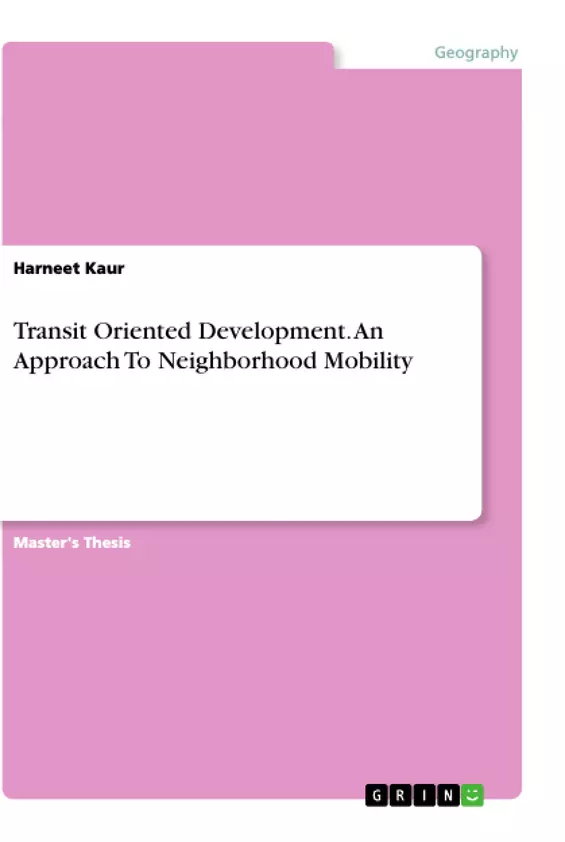The thesis research is divided into three main categories. Firstly, explaining "Emerging Practices" with definitions of different new trends for overcoming various challenges around the globe. Secondly, by ‘Learning lessons’ from best practices and interviewing Experts in this field and the last part of future experiments in section ‘Future Lab’ where these learnings and Challenges are demonstrated together to form recommendations for future proposals. In future Lab, Challenges which are basis of this thesis study; Learnings which are currently happening; and findings which are recommendations from expertise are collected together to form a catalog.
Further integrating these key elements from catalogue help to create a new future proposal. A design model under three different criteria is made and interpret the level of integrating the key elements. Thus, in this future lab of experiments, successful recommendations are delivered to fulfill the goals and objectives of neighborhood mobility concept.
TOD is a prominent solution considered to overcome major urban issues. However, different interpretations of this concept lead to difficulties in conducting TOD. Implementation of TOD is realized on different scales, varying from macro to micro. This thesis research focus on micro scale implementation which refer to neighborhood scale. With new trend of mobility, transit stations in neighborhood are rather used as mobility hubs or combined with other mobility offers. Many people are increasingly using mobility offers that best suit their situation and combine various transport modes flexible with each other. These models are called multimodal or intermodal of mobility. These mobility offers mostly sharing means of transportation like Car Sharing and Bike Sharing integrated in different ways.
Furthermore, it is identified, whether the neighborhood mobility plan is serving only the residents living around this neighborhood or has effect on urban area too. To understand both the cases, two best practices in each case is explained. So, detail overview study of well operating mobility station ‘SWITCHH’ developed in Hamburg, Germany and mobility plan focusing on its residents; ‘Seestadt Aspern’ in Vienna are reviewed. To investigate the success factor, method to approach from concept level to development level and other criteria’s; expert interviews are conducted from the team of mobility concept developers.
Inhaltsverzeichnis (Table of Contents)
- 1.0 Introduction
- 1.1 Challenges
- 1.2 Goals and Objectives
- 1.3 Structure
- 2.0 Transit Oriented Development
- 2.1 Implementation scales
- 2.1.1 Macro Level
- 2.1.2 Micro Level
- 2.2 Neighborhood level mobility
- 2.3 Types of Mobility
- 2.3.3 Multi-modal Mobility
- 2.3.4 Inter-modal Mobility
- 2.4 Elements of Mobility
- 2.4.1 Car sharing
- 2.4.2 Bike sharing
- 2.4.3 Miscellaneous
- 2.1 Implementation scales
- 3.0 Neighborhood mobility trends
- 3.1 Mobility Concept
- 3.2 Mobility Hub
- 3.2.1 Tasks
- 3.2.2 Benefits
- 3.3 Identify type
- 3.4 Case Study –Selection Process
- 3.4.1 Seestadt Aspern, Wien
- 3.4.1(1.0) Learnings
- 3.4.2 Switchh Mobility Station, Hamburg
- 3.4.2 (2.0) Learnings
- 3.4.1 Seestadt Aspern, Wien
- 3.5 Findings - Interview results
- 3.5.1 Findings
- 4.0 Catalogue- Method
- 4.1 Catalogue
- 4.2 Design Model
- 4.2.1 Scenario 1
- 4.2.2 Scenario 2
- 4.2.3 Scenario 3
- 4.3 Integration Level
Zielsetzung und Themenschwerpunkte (Objectives and Key Themes)
This thesis aims to address the identified challenges in urban areas and integrate emerging practices of new mobility trends to deliver recommendations for future mobility solutions.
- Rethinking transit stations in a neighborhood to be much more than just a bus stop or train stop but also to include services and activities which make them more livable place.
- Shifting people from car-oriented transportation to environment-friendly modes by application of urban design aspects.
- Developing a framework in the form of a catalogue to form the basis of sustainable neighborhood mobility required for future needs.
- Delivering recommendations for shared mobility trends from traditional methods and shifting the approach to transit and land-use development under different criteria.
- Creating a study of emerging mobility trends in Europe, especially Germany, while overcoming basic global challenges and developing a model adaptable under various conditions.
Zusammenfassung der Kapitel (Chapter Summaries)
This thesis presents a comprehensive analysis of neighborhood mobility trends, exploring the concept of Transit Oriented Development (TOD) at a micro-scale level. The thesis focuses on the integration of multimodal and intermodal mobility offers in urban neighborhoods, highlighting key aspects of infrastructure, services, and public transit.
- Chapter 1 introduces the study context, outlining the challenges posed by urban sprawl and car dependency, and setting forth the thesis' goals and objectives.
- Chapter 2 explores the concept of TOD, delving into its implementation at various scales and highlighting the importance of neighborhood level mobility. It also examines different types of mobility, including multimodal and intermodal approaches, and discusses key elements of new mobility, such as car sharing, bike sharing, and other miscellaneous options.
- Chapter 3 focuses on neighborhood mobility trends, exploring the concept of mobility stations or hubs and their tasks and benefits. It then analyzes two case studies: Seestadt Aspern, Vienna, a new development neighborhood, and Switchh, Hamburg, a mobility hub integrated into an existing urban environment. The chapter concludes with findings from expert interviews on mobility concept development.
- Chapter 4 presents a catalogue of key aspects for successful neighborhood mobility, categorized into Infrastructure, Services, and Public Transit. These aspects are then applied to three different design scenarios, demonstrating how a mobility hub can be integrated into various urban contexts.
Schlüsselwörter (Keywords)
The primary keywords and focus topics of this thesis include: neighborhood mobility, Transit Oriented Development (TOD), micro-scale planning, multimodal mobility, intermodal mobility, mobility stations, mobility hubs, shared mobility, car sharing, bike sharing, sustainable urban mobility, urban design, and integrated transportation systems.
- Arbeit zitieren
- Harneet Kaur (Autor:in), 2020, Transit Oriented Development. An Approach To Neighborhood Mobility, München, GRIN Verlag, https://www.grin.com/document/824922



